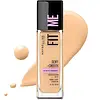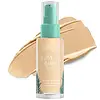What's inside
What's inside
 Key Ingredients
Key Ingredients

 Benefits
Benefits

 Concerns
Concerns

 Ingredients Side-by-side
Ingredients Side-by-side

Ethylhexyl Methoxycinnamate 7%
UV AbsorberWater
Skin ConditioningCyclopentasiloxane
EmollientDimethicone
EmollientGlycerin
HumectantIsotridecyl Isononanoate
EmollientPEG-9 Polydimethylsiloxyethyl Dimethicone
EmulsifyingDisteardimonium Hectorite
StabilisingDimethicone/Polyglycerin-3 Crosspolymer
CleansingSodium Chloride
MaskingPEG-10 Dimethicone
Skin ConditioningPhenoxyethanol
PreservativeMethylparaben
PreservativeDisodium Stearoyl Glutamate
CleansingChlorphenesin
AntimicrobialDisodium EDTA
EDTA
Acrylates Copolymer
Propylparaben
PreservativeParfum
MaskingTocopherol
AntioxidantAscorbyl Palmitate
AntioxidantAluminum Hydroxide
EmollientButylparaben
MaskingPEG-9
HumectantEthylparaben
PreservativeDipropylene Glycol
HumectantAlpha-Isomethyl Ionone
PerfumingTitanium Dioxide
Cosmetic ColorantIron Oxides
Ethylhexyl Methoxycinnamate 7%, Water, Cyclopentasiloxane, Dimethicone, Glycerin, Isotridecyl Isononanoate, PEG-9 Polydimethylsiloxyethyl Dimethicone, Disteardimonium Hectorite, Dimethicone/Polyglycerin-3 Crosspolymer, Sodium Chloride, PEG-10 Dimethicone, Phenoxyethanol, Methylparaben, Disodium Stearoyl Glutamate, Chlorphenesin, Disodium EDTA, EDTA, Acrylates Copolymer, Propylparaben, Parfum, Tocopherol, Ascorbyl Palmitate, Aluminum Hydroxide, Butylparaben, PEG-9, Ethylparaben, Dipropylene Glycol, Alpha-Isomethyl Ionone, Titanium Dioxide, Iron Oxides
Cyclopentasiloxane
EmollientWater
Skin ConditioningButylene Glycol
HumectantPolymethylsilsesquioxane
Glycerin
HumectantLauryl PEG-10 Tris(Trimethylsiloxy)Silylethyl Dimethicone
EmulsifyingAcrylates/Polytrimethylsiloxymethacrylate Copolymer
Skin ConditioningCetyl PEG/PPG-10/1 Dimethicone
EmulsifyingPhenyl Trimethicone
Skin ConditioningDimethicone
EmollientSodium Chloride
MaskingDisteardimonium Hectorite
StabilisingTriethoxycaprylylsilane
Phenoxyethanol
PreservativeCaprylyl Glycol
EmollientParfum
MaskingSilica Dimethyl Silylate
EmollientTribehenin
EmollientAcacia Senegal Gum
MaskingXanthan Gum
EmulsifyingPotassium Sorbate
PreservativeHexylene Glycol
EmulsifyingTetrasodium EDTA
Pentaerythrityl Tetra-Di-T-Butyl Hydroxyhydrocinnamate
AntioxidantTocopheryl Acetate
AntioxidantAstrocaryum Murumuru Seed Butter
EmollientAstrocaryum Tucuma Seed Butter
EmollientButyrospermum Parkii Butter
Skin ConditioningCitrullus Lanatus Seed Extract
Skin ConditioningPunica Granatum Sterols
Skin ConditioningTetrahexyldecyl Ascorbate
AntioxidantTheobroma Grandiflorum Seed Butter
Skin ConditioningLens Esculenta Fruit Extract
Skin ConditioningPyrus Malus Fruit Extract
Skin ConditioningSodium Lactate
BufferingSodium Hyaluronate
HumectantSodium PCA
HumectantSodium Benzoate
MaskingIron Oxides
CI 77891
Cosmetic ColorantCyclopentasiloxane, Water, Butylene Glycol, Polymethylsilsesquioxane, Glycerin, Lauryl PEG-10 Tris(Trimethylsiloxy)Silylethyl Dimethicone, Acrylates/Polytrimethylsiloxymethacrylate Copolymer, Cetyl PEG/PPG-10/1 Dimethicone, Phenyl Trimethicone, Dimethicone, Sodium Chloride, Disteardimonium Hectorite, Triethoxycaprylylsilane, Phenoxyethanol, Caprylyl Glycol, Parfum, Silica Dimethyl Silylate, Tribehenin, Acacia Senegal Gum, Xanthan Gum, Potassium Sorbate, Hexylene Glycol, Tetrasodium EDTA, Pentaerythrityl Tetra-Di-T-Butyl Hydroxyhydrocinnamate, Tocopheryl Acetate, Astrocaryum Murumuru Seed Butter, Astrocaryum Tucuma Seed Butter, Butyrospermum Parkii Butter, Citrullus Lanatus Seed Extract, Punica Granatum Sterols, Tetrahexyldecyl Ascorbate, Theobroma Grandiflorum Seed Butter, Lens Esculenta Fruit Extract, Pyrus Malus Fruit Extract, Sodium Lactate, Sodium Hyaluronate, Sodium PCA, Sodium Benzoate, Iron Oxides, CI 77891
Ingredients Explained
These ingredients are found in both products.
Ingredients higher up in an ingredient list are typically present in a larger amount.
Cyclopentasiloxane, or D5, is a silicone used to improve texture of products and trap moisture.
D5 is considered lightweight and volatile. Volatile means it evaporates quickly after application. Once evaporated, D5 leaves a thin barrier that helps keep skin hydrated.
It is also an emollient. Emollients help soften the skin and prevent water loss. Silicones create a silky texture in products. D5 helps other ingredients become more spreadable.
Studies show D5 is safe to use in skincare products. We recommend speaking with a skincare professional if you have concerns.
Learn more about CyclopentasiloxaneDimethicone is a type of synthetic silicone created from natural materials such as quartz.
What it does:
Dimethicone comes in different viscosities:
Depending on the viscosity, dimethicone has different properties.
Ingredients lists don't always show which type is used, so we recommend reaching out to the brand if you have questions about the viscosity.
This ingredient is unlikely to cause irritation because it does not get absorbed into skin. However, people with silicone allergies should be careful about using this ingredient.
Note: Dimethicone may contribute to pilling. This is because it is not oil or water soluble, so pilling may occur when layered with products. When mixed with heavy oils in a formula, the outcome is also quite greasy.
Learn more about DimethiconeDisteardimonium Hectorite comes from the clay mineral named hectorite. It is used to add thickness to a product.
It can also help stabilize a product by helping to disperse other ingredients.
Hectorite is a rare, white clay mineral.
Learn more about Disteardimonium HectoriteGlycerin is already naturally found in your skin. It helps moisturize and protect your skin.
A study from 2016 found glycerin to be more effective as a humectant than AHAs and hyaluronic acid.
As a humectant, it helps the skin stay hydrated by pulling moisture to your skin. The low molecular weight of glycerin allows it to pull moisture into the deeper layers of your skin.
Hydrated skin improves your skin barrier; Your skin barrier helps protect against irritants and bacteria.
Glycerin has also been found to have antimicrobial and antiviral properties. Due to these properties, glycerin is often used in wound and burn treatments.
In cosmetics, glycerin is usually derived from plants such as soybean or palm. However, it can also be sourced from animals, such as tallow or animal fat.
This ingredient is organic, colorless, odorless, and non-toxic.
Glycerin is the name for this ingredient in American English. British English uses Glycerol/Glycerine.
Learn more about GlycerinParfum is a catch-all term for an ingredient or more that is used to give a scent to products.
Also called "fragrance", this ingredient can be a blend of hundreds of chemicals or plant oils. This means every product with "fragrance" or "parfum" in the ingredients list is a different mixture.
For instance, Habanolide is a proprietary trade name for a specific aroma chemical. When used as a fragrance ingredient in cosmetics, most aroma chemicals fall under the broad labeling category of “FRAGRANCE” or “PARFUM” according to EU and US regulations.
The term 'parfum' or 'fragrance' is not regulated in many countries. In many cases, it is up to the brand to define this term.
For instance, many brands choose to label themselves as "fragrance-free" because they are not using synthetic fragrances. However, their products may still contain ingredients such as essential oils that are considered a fragrance by INCI standards.
One example is Calendula flower extract. Calendula is an essential oil that still imparts a scent or 'fragrance'.
Depending on the blend, the ingredients in the mixture can cause allergies and sensitivities on the skin. Some ingredients that are known EU allergens include linalool and citronellol.
Parfum can also be used to mask or cover an unpleasant scent.
The bottom line is: not all fragrances/parfum/ingredients are created equally. If you are worried about fragrances, we recommend taking a closer look at an ingredient. And of course, we always recommend speaking with a professional.
Learn more about ParfumPhenoxyethanol is a preservative that has germicide, antimicrobial, and aromatic properties. Studies show that phenoxyethanol can prevent microbial growth. By itself, it has a scent that is similar to that of a rose.
It's often used in formulations along with Caprylyl Glycol to preserve the shelf life of products.
Chances are, you eat sodium chloride every day. Sodium Chloride is also known as table salt.
This ingredient has many purposes in skincare: thickener, emulsifier, and exfoliator.
You'll most likely find this ingredient in cleansers where it is used to create a gel-like texture. As an emulsifier, it also prevents ingredients from separating.
There is much debate on whether this ingredient is comedogenic. The short answer - comedogenic ratings don't tell the whole story. Learn more about comegodenic ratings here.
The concensus about this ingredient causing acne seems to be divided. Research is needed to understand if this ingredient does cause acne.
Scrubs may use salt as the primary exfoliating ingredient.
Learn more about Sodium ChlorideWater. It's the most common cosmetic ingredient of all. You'll usually see it at the top of ingredient lists, meaning that it makes up the largest part of the product.
So why is it so popular? Water most often acts as a solvent - this means that it helps dissolve other ingredients into the formulation.
You'll also recognize water as that liquid we all need to stay alive. If you see this, drink a glass of water. Stay hydrated!
Learn more about WaterThis ingredient is a combination of red, black, and yellow iron oxide pigments. This combination of colors is usually found in foundation, because it results in a "skin" color.